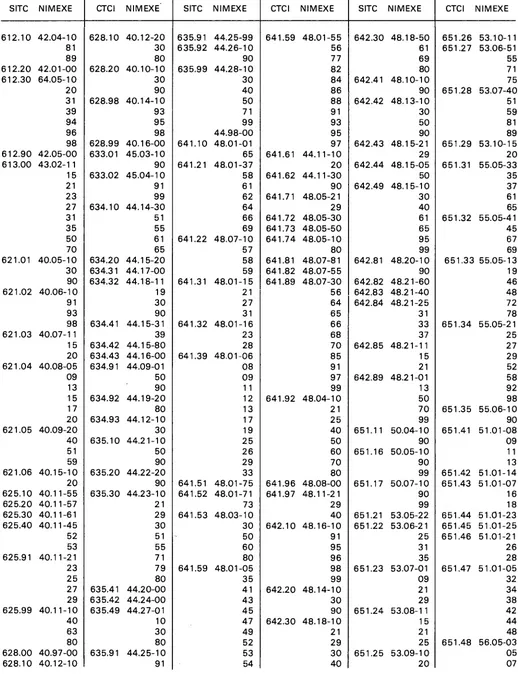fclFFICE STATISTIQUE DES COMMUNAUTES EUROPEENNES STATISTICAL OFFICE OF THE EUROPEAN COMMUNITIES STATISTISCHES AIV
I t DER EUROPÄISCHEN GEMEINSCHAFTEN ISTITUTO STATISTICO DELLE COMUNITÀ EUROPEE BUREAU VOOR DE STATISTIEK DER EURC
■PESE GEMEENSCHAPPEN DET STATISTISKE DEPARTEMENT FOR DE EUROPÆISKE FÆ LLESSKABER O F F I C E STATISTIQUE DES COMMI
I N A U T E S EUROPEENNES STATISTICAL OFFICE OF THE EUROPEAN COMMUNITIES STATISTISCHES AMT DER EUROPÄISCHEN GEMEINSCh
¡AFTEN ISTITUTO STATISTICO DELLE COMUNITÀ EUROPEE BUREAUVOOR DE STATISTIEK DER EUROPESE GEMEENSCHAPPEN D E T SI
I Ä T I S T I S K E DEPARTEMENT FOR DE EUROPÆ ISKE FÆ LLESSKABER OFFICE STATISTIQUE DES COMMUNAUTES; EUROPEENNES STATIST
K A L OFFICE O F T H E 'EUROPEAN COMM UNI TIE S STATISTISCHES A M T D E R EUROP ÄI SCHEN GEME INS CHAFTE N ' I S T I T U T O STATISTICO DE L
¡ L E C O M U N I T À E U R O P E E B U R E A U V O O R D E S T A T I S T I E K D E R E U R O P E S E G E M E E N S C H A P P E N
D E T S T A T I S T I S K E D E P A R T E M E N T F O R D E
I JR OPÆ IS K E F Æ LLESS KABE R OFFI CE STATISTIQUE D E S C O M MU NAUT E S E UROP EE NNES S T A T I S T I C A L OFFICE O F T HE E UROP E AN CC IMMUN ITIES STATISTISCHES A M T D E R EUROP ÄI SCHEN GE MEI NS CHAFTE N, I S T I T U T O STATISTICO DELLE COMUNI TÀ E URO PE E BUREAI IV OOR D E S T A T I S T I E K D E R E U R OP E S E GE M E EN S Ç H A P P E N ^^ E T& T A T JS TJ S K E D E P A R ^■ O F F I C E S T A T I S T I Q U E D E S C O M M L H
IDER EUROPAISCHEN GEMEINSCH^^^^^^^^^^^^^^^^^^^^^^^^^^w^^^^^^Ll^^vwtviõ^^^
■ E S E G E M E E N S C H A P P E N D E T s ^ ^ ^ m ^ ^ ^ ^ m m ^ ^ m ^ m
EE U R O P Æ I S K E F Æ L L E S S K A B E R
O F F I C E S T A T I S T I Q U E D E S C O M M L
I M A U T E S EUROPEENNES S T A T l ï
^ g ^ ^ ^ k
OMMUNITIES STATISTISCHES AMT DER EUROPÄISCHEN GEMEINSÇ
^mmmm^m^m
a t f E A U VOOR DE STATISTIEK DER EUROPESE GEMEENSCHAPPEN DET £
FATISTISKE DEPARTEMENT FOR M
g
M
W "
0FnCESTATISTIQUE DES COMMUNAUTES EUROPEENNES STATISI
■
H
H
^
^
fcjfì
DER EUROPÄISCHEN GEMEINSCHAFTEN ISTITUTO STATISTICO DEI
L E COMUNITÀ EUROPEE B U R E / 1
g
T D P E S E GEMEENSCHAPPEN DET STATISTISKE DEPARTEMENT FOR DE
^ ^ ■ ■ ■ ■ ■ ■ M M ^ ^ H M W N A U T E S EUROPEENNES STATISTICAL OFFICE OF THE EUROPEAN CON
LlUNITIES STATISTISCHES AMT O t t
■ IIL>Lf"V J ~ C 1 ' J~*m § '
E N"
I S T I T U T OSTATISTICO DELLE COMUNITÀ EUROPEE BUREAU V
C T I * .
■ C 3 ^ ^ X | E 5
pVTISTISKE DEPARTEMENT FOR DE EUROPÆ ISKE FÆ LLESSKABER ■
FIC E STATISTIQUE D E S C O M M U N / W ^ P É F F R O F ^ ^ ^ ' ^ Λ Λ FC OFFICE O F T HE EUROP EAN COM MUNI TI ES STATI STISCHES A M T D E









